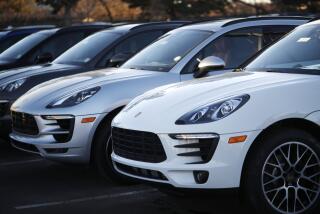Is This Volkswagen’s Savior?
- Share via
Volkswagen of America--amid rumors of its departure from these shores, with sales shrunk to a sprinkle and suffering job cuts amounting to a white-collar massacre--is crawling back to the battle.
* The entire lineup is being shuffled and juggled with the wild but pricey Corrado sport coupe dropped; the saucy Cabrio ragtop returned from exile; the fiery Golf GTI reintroduced, and the Vanagon on again but as the EuroVan with a camper conversion by Winnebago instead of Westphalia.
* Showrooms are suddenly rich with 1994 Golf IIIs and Jetta IIIs after a year of hesitant, spotty deliveries of earlier models fringing on the obsolete.
* Volkswagen has chopped an expensive, top-heavy executive structure and consolidated its U.S. and Canada operations.
* Sales have started breathing again. More than 57,000 VWs were sold in the first seven months of this year--compared to a piddling 50,000 for all of last year.
And now the 1995 Passat comes to pass as a compact sedan and wagon and suddenly the Great Teutonic Hope of Volkswagen’s full recovery.
Could be. For the new Passat GLX is a tautly assembled, able-driving, high-quality machine loaded with safety and convenience equipment for $20,890.
Or maybe not. For as perception lags reality, so anything by Volkswagen is still viewed as a slab-sided, unstylish, frequently unreliable eight ball.
Cognoscenti may choose to sleep with their Volkswagens. But most Americans lump them with Saabs and Volvos as symbols of knowing buyers, rather than fun machines for getting a body someplace.
Another barrier stands against Passat as it is delivered to showrooms this month: It is headed for Accord and Camry country. Ford Taurus, Volvo 850 and Saab 900 also inhabit this rich and profitable land of wonderful sales figures. So do Mazda’s 626, Chrysler’s very successful LH series and upcoming Cirrus/Stratus duet, and the incoming Ford Contour and Mercury Mystique twins.
God only knows how Passat will fare against this horde. And it is rumored he drives a Volvo 850 Turbo.
Although Volkswagen has made efforts to smooth and round Passat’s exterior--there’s a slatted grille now, and stylists claim 90% of the sheet metal is new--it all appears more of a tickle than a make-over. The styling shows little sensuality in this decade of aerodynamics and cabs forward. Even from the next county, Passat clearly is another Volkswagen, which means straight,lines and soft boxiness, a snub hood and bobbed trunk.
Power is from a 2.8-liter V-6 producing 172 horsepower and a proven, hard-pulling little engine. But it is unchanged from last year and that could be another slip. Toyota’s Camry is 10% more potent.
Where Passat earns more than passing grades is as a high-value package, quite the trend these days. The only options are automatic transmission, leather seats, a sunroof, CD player and heated seats adding a relatively scant $3,300 to the base $20,890. Everything else is included in the sticker price--driver and passenger air bags, anti-lock brakes, traction control, alarm system, air conditioning, trip computer, power windows, cruise control, BBS alloy wheels, et cetera, ad infinitum and quite splendidly.
There’s even a minor miracle on-board--three cup holders on a German car. Although as Volkswagen gives, so it taketh away. Thanks to the bulk of a passenger-side air bag and a decision to stick with chubby knee bolsters, there is no glove box.
Fault will also be found with the Passat’s dashboard. The primary instruments are analog and large and an easy read for even the optically challenged. But Volkswagen has reverted to dippy black-on-gray digitals for clock, odometer and gear indicator that are a squint to read from behind Ray-Bans. Or in bright, following sunlight.
Although the cabin is quite roomy--best in its crowded class, in fact--finding the right setting for the driver’s seat is a couple of wriggles removed from being damned difficult. When notched and secure, one is still not too sure which control did what. And taller folk will find the back seats barely score a B minus in gluteal comfort.
*
Yet all the right reasons for ever buying a Volkswagen remain. Passat is a tough sedan with that sense of one-piece solidity, weight and integration unique to German cars. And a chassis 30% stiffer than current models certainly enhances heft and balance.
The V-6 is sure, happy, and delights in feeling the whip in its mid to upper ranges. Even when mated to a four-speed automatic, the bleeding of power is minimal and acceleration remains a firm rush.
Suspension flexes on the choppy side of its geometry, leaving no doubt this is a car for souls who like to extract exhilaration from their driving.
Well-balanced steering allows perfect pitching into corners, 172-horsepower provides purposeful exits, and this car does nothing that can’t be predicted several thoughts in advance.
It is a car bred to be a chaser, ne’er a follower, offering motoring adventure identical to another quicksilver sedan, the Nissan Maxima.
Next year, Volkswagen plans to expand its line with a punier Passat powered only by a 115-horsepower four-banger.
Deeply in love with the V-6 version, we can’t think why.
* Paul Dean’s Behind the Wheel column is published every other Friday.
1995 Volkswagen Passat GXL
Price: $20,890.
The Good: Priced right and highest example of value packaging. Enthusiastic performer for enthusiast drivers. Potential class winner, if class willing to make room.
The Bad: Styling still blocky Volkswagen.
The Ugly: Quasi-digital dash.
1995 Volkswagen Passat GXL
Cost
* As tested, $23,395 (Includes optional leather seats, power sun roof, automatic transmission. Also standard anti-lock brakes, cruise control, alarm, central locking, traction control, two air bags, BBS wheels, cup holders, remote trunk release.)
Engine
* 2.8-liter V-6 developing 172 horsepower.
Type
* Front-engine, front-drive, compact sedan.
Performance
* 0-60 m.p.h., as tested, with automatic, 10.1 seconds.
* Top speed, electronically limited, 130 m.p.h.
* Fuel consumption, EPA city and highway, 18 and 25 m.p.g.





